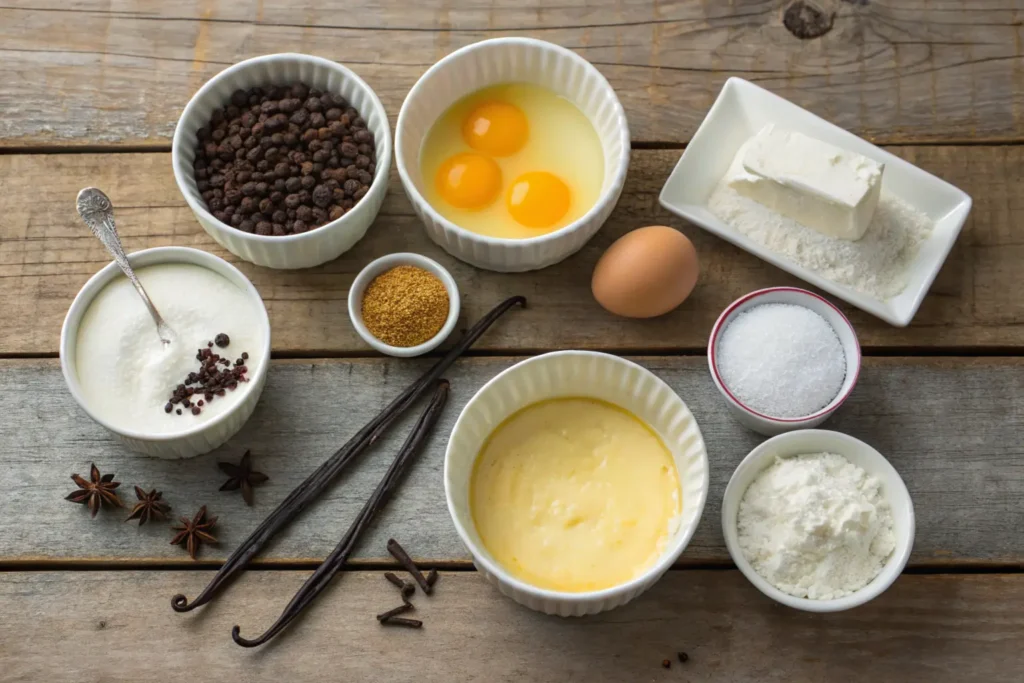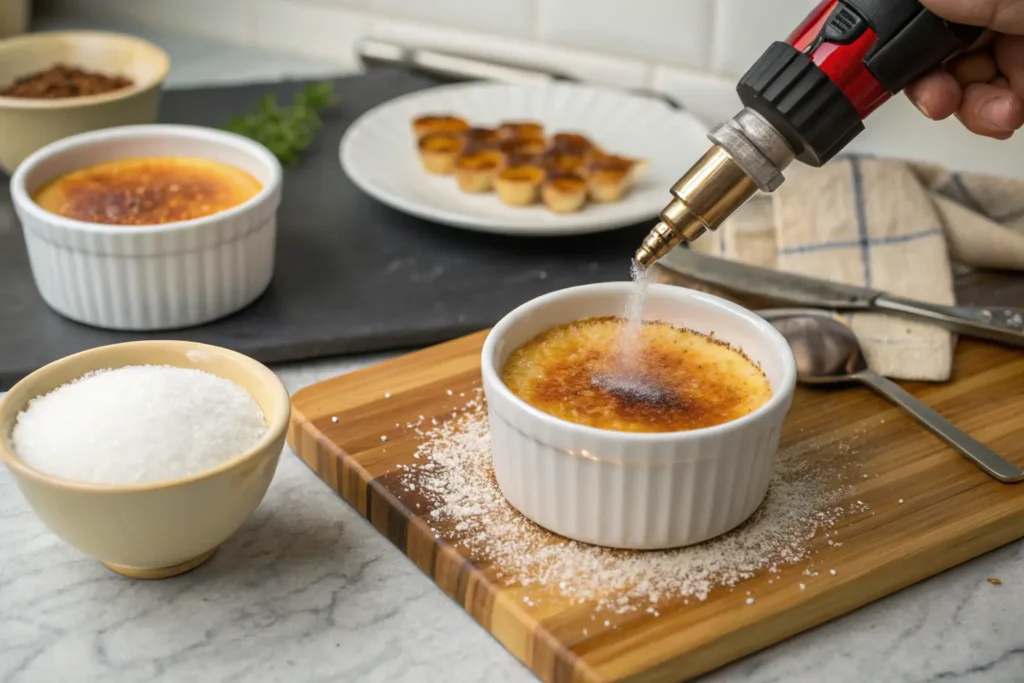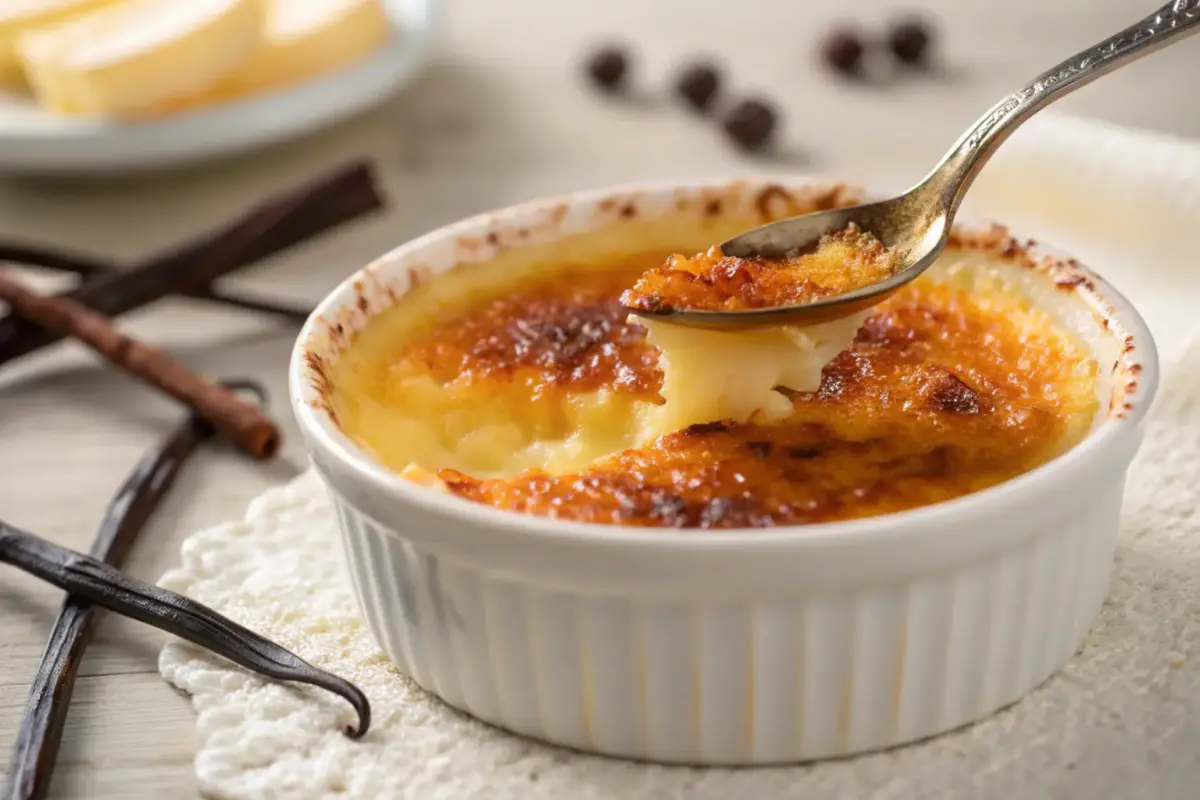What is a Crème Brûlée?
Crème brûlée, a classic dessert loved for its contrast of textures, is a masterpiece of culinary simplicity and elegance. At its core, this dish combines a velvety custard base with a caramelized sugar topping that cracks delightfully under a spoon. Notably, the dessert’s charm lies in its perfect balance of creamy and crunchy elements, which work together to create a unique dining experience.
Traditionally, the custard is flavored with vanilla, although variations featuring chocolate, coffee, or fruit infusions have also gained popularity. While the custard provides a smooth and rich foundation, the caramelized sugar layer adds a crisp, sweet finish, ensuring every bite is indulgent. Furthermore, the preparation process, though seemingly simple, requires attention to detail to achieve that signature crème brûlée top. This dessert, found in fine dining and home kitchens alike, remains a timeless treat that never fails to impress.
The History of Crème Brûlée
The origins of crème brûlée can be traced back to 17th-century Europe. Its name, meaning “burnt cream” in French, reflects the dessert’s defining feature: the caramelized sugar crust. While France is most associated with the dish, England and Spain have similar versions. England’s “Trinity Cream” and Spain’s “Crema Catalana” offer variations that predate or parallel the French version.
Though crème brûlée gained widespread popularity in the 20th century, its appeal remains timeless. The method of caramelizing sugar over custard has made it a favorite for its simplicity and elegance. Understanding its history adds depth to the appreciation of this culinary masterpiece, making the journey of creating the perfect crème brûlée top even more rewarding.
Key Components of a Perfect Crème Brûlée
Achieving the ideal crème brûlée requires a harmonious combination of components. First, the custard base must be smooth and velvety, free from lumps or bubbles. The key lies in using fresh cream, high-quality eggs, and pure vanilla extract to enhance the flavor and texture.
Equally important is the sugar layer. The right sugar ensures even caramelization, creating a crisp shell. Fine granulated sugar works best, as it melts evenly and forms a uniform crust. Both components must complement each other, delivering a dessert that is as delightful to eat as it is to prepare.
Tools Needed for Making a Crème Brûlée Top
Essential Kitchen Tools
To prepare crème brûlée, you’ll need a few basic kitchen tools:
- Ramekins: Small, oven-safe dishes ensure even cooking of the custard.
- Mixing Bowl and Whisk: These are essential for blending the custard ingredients.
- Fine Strainer: Ensures the custard is smooth by removing any lumps or bubbles.
- Baking Dish: Holds the ramekins during the water bath baking process.
These tools make the process efficient, ensuring each step contributes to a perfect result.
Choosing the Right Torch
The culinary torch is indispensable for achieving the iconic crème brûlée top. It allows for precise control over the caramelization process, ensuring the sugar melts evenly. When selecting a torch, consider these factors:
- Size and Flame Control: A torch with adjustable flame settings offers better precision.
- Fuel Type: Butane is the most common choice due to its clean burn and availability.
- Ergonomic Design: A comfortable grip ensures safe handling.
For those without a torch, the oven broiler is an alternative, though it may lack the same level of control. Regardless of the method, the goal is to create a crisp, caramelized top that cracks with a gentle tap.
Preparing the Crème Brûlée Base

Ingredients for the Custard
The custard base is the heart of a crème brûlée. To achieve a silky texture and rich flavor, use the following ingredients:
- Heavy Cream: Provides the creamy foundation.
- Egg Yolks: Add richness and structure to the custard.
- Granulated Sugar: Balances the sweetness.
- Vanilla Extract: Enhances the flavor profile.
Opt for fresh, high-quality ingredients, as they directly impact the final result. Proper measurements and ratios ensure the custard sets correctly while maintaining its creamy consistency.
Step-by-Step Custard Preparation
- Preheat the Oven: Set the temperature to 325°F (160°C) to prepare for the water bath.
- Heat the Cream: In a saucepan, gently warm the heavy cream until it’s just below boiling. Add vanilla for an aromatic touch.
- Whisk Egg Yolks and Sugar: Combine egg yolks and sugar in a bowl until the mixture is pale and smooth.
- Temper the Eggs: Gradually add the warm cream to the egg mixture, whisking constantly to avoid curdling.
- Strain the Custard: Pour the mixture through a fine strainer to remove any lumps.
- Pour into Ramekins: Divide the custard evenly among the ramekins.
- Bake in a Water Bath: Place ramekins in a baking dish filled with hot water, ensuring the water reaches halfway up the sides. Bake for 35–40 minutes until the custard is set but slightly jiggly in the center.
- Cool and Chill: Allow the custards to cool before refrigerating them for at least 2 hours.
Following these steps guarantees a smooth custard that pairs perfectly with the caramelized top.
Achieving the Perfect Caramelized Top

The Role of Sugar
The choice of sugar is vital in creating a crackable crème brûlée top. Fine granulated sugar melts quickly, forming an even layer that caramelizes efficiently. Too much sugar can result in a thick, overly sweet crust, while too little may leave gaps.
Before caramelizing, sprinkle an even layer of sugar over the chilled custard. Tilt the ramekin to ensure the sugar coats the surface uniformly. A light, consistent layer ensures optimal caramelization, balancing the texture and flavor of the dessert.
Techniques for Caramelizing Sugar
Caramelizing sugar requires precision and patience. Begin by holding the torch at an angle, maintaining a steady flame as you move it across the sugar. Keep the flame about 2 inches away from the surface to prevent burning.
For best results:
- Start at the Edges: Begin caramelizing the edges before moving toward the center.
- Move Steadily: Avoid lingering in one spot to prevent uneven melting.
- Cool Briefly: Allow the caramelized sugar to harden for a minute before serving.
With practice, you’ll create a perfectly crisp, golden-brown crust every time. The combination of a creamy custard base and a crackling sugar top makes the effort worthwhile, ensuring a memorable dessert experience.
Common Mistakes and How to Avoid Them
Overcooking the Sugar
One of the most common mistakes in achieving a perfect crème brûlée top is overcooking the sugar. When the sugar is exposed to the torch for too long, it can transition from caramelized to burnt, resulting in a bitter taste and an unpleasant crust.
To avoid this, always keep the flame moving. Focus on gradually melting the sugar layer rather than rushing the process. Hold the torch at an angle, about 2 inches away from the surface, and monitor the color closely. The goal is to achieve a golden-brown crust with a glossy finish. If the sugar starts to darken too quickly, reduce the flame or increase the distance between the torch and the ramekin.
Uneven Caramelization
Uneven caramelization occurs when the sugar layer is not distributed evenly or when the torching technique is inconsistent. Some areas are burnt while others remain raw.
To prevent this, start with a uniform layer of sugar. Use fine granulated sugar and shake the ramekin gently to spread it evenly across the custard surface. When torching, move the flame in steady, circular motions, ensuring all areas receive equal heat. Practice and patience are key to mastering this step.
Advanced Tips for a Professional Finish
Adding Flavors to the Sugar
Infusing the sugar with flavors can add a unique twist to your crème brûlée. For instance:
- Citrus Zest: Mix a small amount of lemon or orange zest into the sugar before caramelizing.
- Spices: Incorporate a pinch of cinnamon, nutmeg, or cardamom for a warm, aromatic touch.
- Vanilla Sugar: Use sugar infused with vanilla beans to enhance the overall flavor profile.
When using flavored sugar, ensure it’s finely ground to allow for even melting. The added elements should complement, not overpower, the custard’s taste.
Using Different Sugars for Unique Textures
Experimenting with different types of sugar can yield interesting textures and flavors for the crème brûlée top. Consider these options:
- Turbinado Sugar: Its larger crystals create a thicker, crunchier crust.
- Brown Sugar: Adds a caramel-like depth of flavor but may require more careful torching due to its moisture content.
- Coconut Sugar: Offers a nutty, earthy sweetness for a unique variation.
Each sugar type reacts differently to heat, so practice is essential to perfect the caramelization process.
How to Achieve the Perfect Crème Brûlée Top?
Creating a flawless crème brûlée top requires attention to detail, the right tools, and a precise method. The caramelized sugar layer not only adds a crisp texture but also enhances the dessert’s visual and flavor appeal. Here’s a detailed guide to ensure your crème brûlée top is perfect every time.
Choosing the Right Sugar and Tools
Fine granulated sugar is key to achieving an evenly melted, crackable crust. When caramelizing, a culinary torch is preferred for precision, though alternatives like an oven broiler can suffice for home cooks. Learn more about what goes into crème brûlée and how these elements contribute to its iconic caramelized top.
Caramelizing Techniques
To avoid burning, hold the torch 2 inches away and move it steadily in circular motions. Begin at the edges, working your way to the center. Explore the taste profile of crème brûlée to better understand how caramelization complements its custard base.
Common Mistakes to Avoid
Avoid uneven sugar distribution or over-torching, as these can lead to burnt or uneven layers. Practice ensures perfection! For a deeper dive into the process, discover the differences between crème brûlée and custard and refine your approach to mastering this dessert.
Frequently Asked Questions About Crème Brûlée
Can I Make a Crème Brûlée Without a Torch?
Yes, you can use an oven broiler as an alternative to a torch. Place the ramekins on a baking sheet and position them under the broiler, keeping a close eye on the sugar to prevent burning. The broiler may not offer the same precision as a torch, but it can still create a caramelized top.
What Type of Sugar Works Best for Caramelizing?
Fine granulated sugar is the best choice for caramelizing a crème brûlée top. Its small crystals melt quickly and evenly, forming a smooth, crackable crust. Avoid powdered or coarse sugar, as they may not caramelize uniformly.
How Do I Fix a Burnt Top?
If the sugar layer is burnt, gently scrape it off using a spoon once it cools. Add a fresh layer of sugar and caramelize again, being more cautious with the flame. Avoid overheating the custard during this process to maintain its integrity.
Can I Prepare the Custard in Advance?
Yes, the custard can be prepared up to two days in advance. After baking, let it cool to room temperature before covering it tightly with plastic wrap and refrigerating. Caramelize the sugar just before serving to preserve the crisp texture of the crème brûlée top.
Is There a Way to Achieve a Thicker Caramel Layer?
For a thicker caramel layer, use a slightly larger amount of sugar. However, ensure it is evenly distributed and caramelize it gradually to prevent burning. Using turbinado sugar can also help achieve a more substantial crust.
What Should I Do If My Custard Is Runny?
Runny custard usually results from undercooking or incorrect proportions of ingredients. To fix this:
- Ensure the custards are baked in a water bath at the correct temperature (325°F or 160°C).
- Check for doneness by gently shaking the ramekin; the edges should be set while the center remains slightly jiggly.
- Always follow the recipe’s recommended ratios for cream and egg yolks to achieve the right consistency.
Conclusion: Perfecting Your Crème Brûlée Top Every Time
Perfecting a crème brûlée top may seem challenging at first, but with the right techniques and a little practice, it becomes an achievable culinary triumph. By combining high-quality ingredients, proper tools, and attention to detail, you can recreate this timeless dessert at home with confidence. Importantly, avoiding common mistakes, such as overcooking the sugar or uneven caramelization, ensures a flawless finish.
Moreover, experimenting with advanced techniques, like adding flavored sugars or trying different types of sugar, allows you to put your own spin on this classic treat. Each step, from preparing the silky custard base to achieving the crisp caramelized top, contributes to a dessert that is as satisfying to make as it is to eat.
In the end, the effort is well worth it. A perfectly crafted crème brûlée top not only elevates the dessert’s texture and flavor but also leaves a lasting impression on anyone lucky enough to enjoy it. With these insights and methods, you’re well-equipped to create a masterpiece every time.


2 thoughts on “How to make a crème brûlée top?”